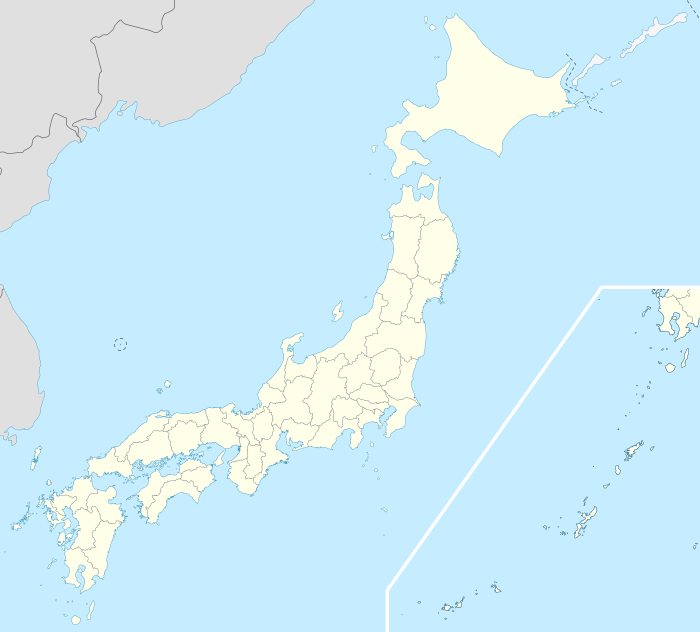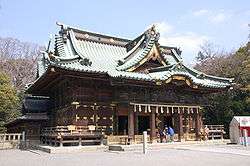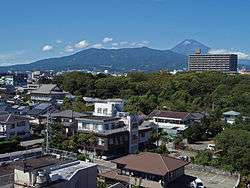Mishima, Shizuoka
| Mishima 三島市 | |||
|---|---|---|---|
| City | |||
|
downtown Mishima | |||
| |||
 Location of Mishima in Shizuoka Prefecture | |||
 Mishima
| |||
| Coordinates: 35°07′6.6″N 138°55′6.8″E / 35.118500°N 138.918556°ECoordinates: 35°07′6.6″N 138°55′6.8″E / 35.118500°N 138.918556°E | |||
| Country | Japan | ||
| Region | Chūbu (Tōkai) | ||
| Prefecture | Shizuoka Prefecture | ||
| Government | |||
| • -Mayor | Takeshi Toyooka (since December 2010) | ||
| Area | |||
| • Total | 62.02 km2 (23.95 sq mi) | ||
| Population (September 2015) | |||
| • Total | 110,187 | ||
| • Density | 1,780/km2 (4,600/sq mi) | ||
| Time zone | Japan Standard Time (UTC+9) | ||
| City symbols | |||
| • Tree | Ginkgo biloba | ||
| • Flower | Mishima sakura | ||
| • Bird | European kingfisher | ||
| Phone number | 055-975-3111 | ||
| Address | 4-47 Kitatamachi, Mishima-shi, Shizuoka-ken 411-8666 | ||
| Website |
www | ||


Mishima (三島市 Mishima-shi) is a city located in eastern Shizuoka Prefecture, Japan.
As of September 2015, the city had an estimated population of 110,187 and a population density of 1,780 persons per km2. The total area was 62.02 square kilometres (23.95 sq mi).
Geography
Mishima is located in far eastern Shizuoka Prefecture, at the northern end of Izu Peninsula and in the foothills of Mount Fuji.
Surrounding municipalities
Climate
Mishima has a humid continental climate (Köppen climate classification Cfa) with hot summers and cool winters. Precipitation is significant throughout the year, but is heaviest from June to September.
| Climate data for Mishima, Shizuoka | |||||||||||||
|---|---|---|---|---|---|---|---|---|---|---|---|---|---|
| Month | Jan | Feb | Mar | Apr | May | Jun | Jul | Aug | Sep | Oct | Nov | Dec | Year |
| Average high °C (°F) | 10.9 (51.6) |
11.2 (52.2) |
14.0 (57.2) |
19.1 (66.4) |
23.1 (73.6) |
25.7 (78.3) |
29.0 (84.2) |
30.9 (87.6) |
27.4 (81.3) |
22.3 (72.1) |
18.0 (64.4) |
13.4 (56.1) |
20.42 (68.75) |
| Daily mean °C (°F) | 5.0 (41) |
5.6 (42.1) |
8.6 (47.5) |
13.9 (57) |
18.1 (64.6) |
21.5 (70.7) |
25.0 (77) |
26.3 (79.3) |
22.9 (73.2) |
17.2 (63) |
12.3 (54.1) |
7.3 (45.1) |
15.31 (59.55) |
| Average low °C (°F) | −0.5 (31.1) |
0.4 (32.7) |
3.3 (37.9) |
8.9 (48) |
13.2 (55.8) |
17.9 (64.2) |
21.9 (71.4) |
22.7 (72.9) |
19.1 (66.4) |
12.7 (54.9) |
7.2 (45) |
1.7 (35.1) |
10.71 (51.28) |
| Average precipitation mm (inches) | 73.9 (2.909) |
87.0 (3.425) |
153.2 (6.031) |
161.6 (6.362) |
165.3 (6.508) |
251.3 (9.894) |
198.1 (7.799) |
221.8 (8.732) |
221.8 (8.732) |
154.0 (6.063) |
110.1 (4.335) |
60.7 (2.39) |
1,858.8 (73.18) |
| Average snowfall cm (inches) | 2 (0.8) |
1 (0.4) |
0 (0) |
0 (0) |
0 (0) |
0 (0) |
0 (0) |
0 (0) |
0 (0) |
0 (0) |
0 (0) |
0 (0) |
3 (1.2) |
| Average relative humidity (%) | 66 | 66 | 67 | 71 | 73 | 78 | 80 | 78 | 78 | 76 | 74 | 70 | 73.1 |
| Mean monthly sunshine hours | 172.9 | 145.3 | 160.1 | 155.4 | 175.9 | 121.3 | 132.2 | 180.1 | 130.2 | 139.9 | 144.6 | 169.2 | 1,827.1 |
| Source: NOAA (1961-1990) [1] | |||||||||||||
History
Mishima is an ancient town, which developed around the important Shinto shrine of Mishima Shrine (三嶋大社 Mishima Taisha). Under the Ritsuryo administration system established in the Nara period, Mishima was made capital of Izu Province. It was also the location of the Kokubun-ji for Izu Province. In the Edo period, Mishima prospered from its location on the Tōkaidō highway connecting Edo with Kyoto, and Mishima-shuku was one of the 53 post stations on that road. The area was tenryō territory ruled by a daikan appointed directly by the Tokugawa shogunate. After the Meiji Restoration, Mishima became part of the short-lived Nirayama Prefecture in 1868. This merged with the equally short-lived Ashigara Prefecture in 1871, and became part of Shizuoka Prefecture from April 18, 1876. During the cadastral reform of 1889, the area was reorganized as Mishimi Town within Kimisawa District. In 1892, Prince Komatsu Akihito established a villa in Mishima. Its gardens, the Rakujūen, are a noted visitor attraction in Mishima to this day. In 1896, Kimisawa District became part of Tagata District, Shizuoka. Mishima received its first train connection in 1898 when the predecessor of the Izuhakone Railway established what is now Shimo-Togari Station. The Sunzu Line began operations from 1906. However, Mishima's fortunes revived strongly only after the Tanna Tunnel was completed in 1934, connecting the town to the Tōkaidō Main Line railway between Tokyo and Shizuoka. Mishima developed rapidly afterwards, merging with neighboring Kitakami Village in 1935 and Watada Village in 1941. Mishima Town was elevated in status to a city on April 29, 1941. It became a stop on the Tōkaidō Shinkansen from 1969, leading to an expansion in population, as the line made it possible to commute to Tokyo.
Economy
Mishima is a major industrial center within Shizuoka Prefecture. In addition to a railroad repair facility operated by JR Central, the city hosts factories from:
- Toray
- DMW Corporation
- Toshiba TEC Corporation
- Yokohama Rubber Company
- CFS Corporation (HAC Drugstores)
- Izuhakone Railway Company Ltd
Education
Mishima has 14 elementary schools, eight middle schools, and five high schools. In addition, Juntendo University and the Graduate University for Advanced Studies each have a facility at Mishima.
Sister City relations
-
 Pasadena, California, United States,[2] since July 24, 1957
Pasadena, California, United States,[2] since July 24, 1957 -
 New Plymouth, New Zealand,[3] since April 29, 1991
New Plymouth, New Zealand,[3] since April 29, 1991 -
 Lishui, Zhejiang Province, China,[3] since May 12, 1997
Lishui, Zhejiang Province, China,[3] since May 12, 1997
Transport
Railway
- JR Central – Tōkaidō Shinkansen
- JR Central – Tōkaidō Main Line
- Mishima Station
- Izuhakone Railway – Sunzu Line
- Mishima – Mishima-Hirokōji – Mishima-Tamachi – Mishima-Futsukamachi – Daiba
Highways
Education
The College of International Relations for Nihon University is located in Mishima. Mishima is also home to the National Institute of Genetics.
Culture
- Novelist Kimitake Hiraoka adopted his pen name Yukio Mishima after the city.
- The Mishima Summer Festival takes place from August 15 to 17 every year, in and around the Mishima Taisha shrine, as well as near Mishima Station. Mikoshi are carried through the streets and the taiko are played.
- Mishima is home to the Ryūtaku-ji Rinzai Zen temple.
- Vangi Sculpture Garden Museum, Izu Photo Museum and Yukio Literary Museum are all located close together outside Mishima City.
Notable people from Mishima
- Makoto Ooka - poet and literary critic
- Yukiko Sakamoto - politician
- Nobuyoshi Sano - composer and musician
- Naohiro Takahara - professional soccer player
References
- ↑ "Mishima Climate Normals 1961-1990". National Oceanic and Atmospheric Administration. Retrieved January 2, 2012.
- ↑ "US-Japan Sister Cities by State". Asia Matters for America. Honolulu, HI: East-West Center. Retrieved 20 November 2015.
- 1 2 "International Exchange". List of Affiliation Partners within Prefectures. Council of Local Authorities for International Relations (CLAIR). Retrieved 21 November 2015.
External links
| Wikivoyage has a travel guide for Mishima. |
![]() Media related to Mishima, Shizuoka at Wikimedia Commons
Media related to Mishima, Shizuoka at Wikimedia Commons
- Official website (Japanese)


